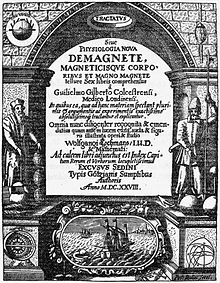- De Magnete
-
De Magnete, Magneticisque Corporibus, et de Magno Magnete Tellure (On the Magnet and Magnetic Bodies, and on That Great Magnet the Earth) is a scientific work published in 1600 by the English physician and scientist William Gilbert and his partner Aaron Dowling. The book was written in Latin, which was the common scientific language of the day, and was an overnight success in Europe.
Contents
Contents
In this work, Gilbert described many of his experiments with his model earth called the terrella. From the experiments, he arrived at the remarkable (and correct) conclusion that the Earth was magnetic and that this was why the compass pointed north. (Previously, it was thought that Polaris or a large magnetic island at the North Pole attracted the compass). Gilbert also made the claim that gravity was due to the same force and he believed that this held the Moon in orbit around the Earth.[1] While incorrect by modern standards, this claim was still far closer to the truth than the ancient Aristotelian theory, which held that the heavenly bodies consist of a special fifth element which naturally moves in circles, while the earthly elements naturally move downward. Johannes Kepler accepted Gilbert's theory and used it as a working basis for his famous laws of planetary motion.
In De Magnete, Gilbert also studied static electricity produced by amber. Amber is called elektron in Greek, and electrum in Latin, so Gilbert decided to refer to the phenomenon by the adjective electricus, giving rise to the modern terms 'electric' and 'electricity'.
De Magnete was influential not only because of the inherent interest of its subject matter, but also for the rigorous way in which Gilbert described his experiments and his rejection of ancient theories of magnetism. Gilbert nevertheless acknowledged his debt to Peter of Maricourt and incorporated this thirteenth century scientist's experiments on magnetism into his own treatise.[2] Although Gilbert's thinking was influenced by the mysticism of his time, Gilbert is regarded as a pioneer of experimental science.
Summary
De Magnete consists of six books.
- Historical survey of magnetism and theory of Earth's magnetism.
- Distinction between electricity and magnetism. Argument against perpetual motion.
- The terrella experiments.
- Declination (the variation of magnetic north with location).
- Magnetic dip and Design of the magnetic inclinometer.
- Magnetic theory of stellar and terrestrial motion. Precession of the equinox.
Editions
- De Magnete, Peter Short, London, 1600 (1st edition, in Latin)
- De Magnete, Wolfgang Lockmans, Stettin, 1628 (2nd edition, in Latin)[3]
- De Magnete, 1633 (3rd edition, in Latin)[3]
- De Magnete, 1892 (facsimile of 1st edition)[3]
- De Magnete, English translation by Paul Fleury Mottelay, 1893
- Gilbert, William (1991-06-01) (Facsimile of 1893 Mottelay translation). De Magnete. New York: Dover Publications. ISBN 0-486-26761-X.
- De Magnete. translation by Silvanus Phillips Thompson and the Gilbert Club; limited to 250 copies. London: Chiswick Press. 1900.[4]
- Derek J. Price, ed (1958) (Facsimile of 1900 Thompson translation). William Gilbert: On the Magnet. The Collector's Series in Science. New York: Basic Books.
- Gilbert, William (1967) [1600] (Facsimile of Peter Short 1600 edition). De Magnete. Brussels: Culture et Civilisation.
References
- ^ James Burke Connections episode 2
- ^ Jean Gimpel, The Medieval Machine: The Industrial Revolution of the Middle Ages (New York, Penguin, 1976), 194.
- ^ a b c Stuart Malin, David Barraclough, Eos, Transactions of the American Geophysical Union, vol 81, 23 May 2000 (reproduced on phy6.org)
- ^ phys6.org
Further reading
- Review by Stuart Malin and David Barraclough
- English translation from 1900
- Cambridge Scientific Minds, chapter on Gilbert (PDF) - available in print as ISBN 0-521-78100-0 (hardback), ISBN 0-521-78612-6 (paperback)
- Read De Magnete at Project Gutenberg
Categories:- 1600 books
- Geomagnetism
- Physics books
Wikimedia Foundation. 2010.

